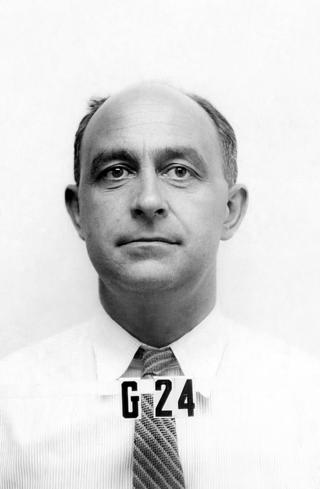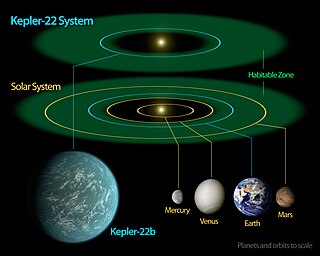
Astrobiology is a scientific field within the life and environmental sciences that studies the origins, early evolution, distribution, and future of life in the universe by investigating its deterministic conditions and contingent events. As a discipline, astrobiology is founded on the premise that life may exist beyond Earth.

The Drake equation is a probabilistic argument used to estimate the number of active, communicative extraterrestrial civilizations in the Milky Way Galaxy.
Extraterrestrial life, or alien life, is life that originates from another world rather than on Earth. No extraterrestrial life has yet been scientifically conclusively detected. Such life might range from simple forms such as prokaryotes to intelligent beings, possibly bringing forth civilizations that might be far more, or far less, advanced than humans. The Drake equation speculates about the existence of sapient life elsewhere in the universe. The science of extraterrestrial life is known as astrobiology.

The Fermi paradox is the discrepancy between the lack of conclusive evidence of advanced extraterrestrial life and the apparently high likelihood of its existence. Those affirming the paradox generally conclude that if the conditions required for life to arise from non-living matter are as permissive as the available evidence on Earth indicates, then extraterrestrial life would be sufficiently common such that it would be implausible for it not to have been detected yet.

Anthem is a dystopian fiction novella by Russian–American writer Ayn Rand, written in 1937 and first published in 1938 in the United Kingdom. The story takes place at an unspecified future date when mankind has entered another Dark Age. Technological advancement is now carefully planned and the concept of individuality has been eliminated. A young man known as Equality 7-2521 rebels by doing secret scientific research. When his activity is discovered, he flees into the wilderness and is followed by Liberty 5-3000, a woman he loves. Together they plan to establish a new society based on rediscovered individualism.

Harlow Shapley was an American scientist, head of the Harvard College Observatory (1921–1952), and political activist during the latter New Deal and Fair Deal.

In planetary astronomy and astrobiology, the Rare Earth hypothesis argues that the origin of life and the evolution of biological complexity, such as sexually reproducing, multicellular organisms on Earth, and subsequently human intelligence, required an improbable combination of astrophysical and geological events and circumstances. According to the hypothesis, complex extraterrestrial life is an improbable phenomenon and likely to be rare throughout the universe as a whole. The term "Rare Earth" originates from Rare Earth: Why Complex Life Is Uncommon in the Universe (2000), a book by Peter Ward, a geologist and paleontologist, and Donald E. Brownlee, an astronomer and astrobiologist, both faculty members at the University of Washington.

In astronomy and astrobiology, the habitable zone (HZ), or more precisely the circumstellar habitable zone (CHZ), is the range of orbits around a star within which a planetary surface can support liquid water given sufficient atmospheric pressure. The bounds of the HZ are based on Earth's position in the Solar System and the amount of radiant energy it receives from the Sun. Due to the importance of liquid water to Earth's biosphere, the nature of the HZ and the objects within it may be instrumental in determining the scope and distribution of planets capable of supporting Earth-like extraterrestrial life and intelligence.
Archibald Fairly Carr Jr. was an American herpetologist, ecologist, and conservationist. He was a Professor of Zoology at the University of Florida and a writer on science and nature. He brought attention to the world's declining sea turtle populations due to over-exploitation and habitat loss. Wildlife refuges in Florida and Costa Rica have been named in his honor.

A Million Random Digits with 100,000 Normal Deviates is a random number book by the RAND Corporation, originally published in 1955. The book, consisting primarily of a random number table, was an important 20th century work in the field of statistics and random numbers.

Planetary habitability is the measure of a planet's or a natural satellite's potential to develop and maintain an environment hospitable to life. Life may be generated directly on a planet or satellite endogenously. Research suggests that life may also be transferred from one body to another, through a hypothetical process known as panspermia. Environments do not need to contain life to be considered habitable nor are accepted habitable zones (HZ) the only areas in which life might arise.
A K Peters, Ltd. was a publisher of scientific and technical books, specializing in mathematics and in computer graphics, robotics, and other fields of computer science. They published the journals Experimental Mathematics and the Journal of Graphics Tools, as well as mathematics books geared to children.

The RAND Corporation is an American nonprofit global policy think tank, research institute, and public sector consulting firm. RAND Corporation engages in research and development (R&D) in a number of fields and industries. Since the 1950s, RAND research has helped inform United States policy decisions on a wide variety of issues, including the space race, the Vietnam War, the U.S.-Soviet nuclear arms confrontation, the creation of the Great Society social welfare programs, and national health care.
Caleb Asa Scharf is a British-American astronomer and popular science author. He is currently the senior scientist for astrobiology at the NASA Ames Research Center in Mountain View, California. He formerly served as the director of the multidisciplinary Columbia Astrobiology Center at Columbia University, New York.

Kepler-22b is an exoplanet orbiting within the habitable zone of the Sun-like star Kepler-22. It is located about 640 light-years from Earth in the constellation of Cygnus. It was discovered by NASA's Kepler Space Telescope in December 2011 and was the first known transiting planet to orbit within the habitable zone of a Sun-like star, where liquid water could exist on the planet's surface. Kepler-22 is too dim to be seen with the naked eye.

In astrobiology and planetary astrophysics, the galactic habitable zone is the region of a galaxy in which life is most likely to develop. The concept of a galactic habitable zone analyzes various factors, such as metallicity and the rate and density of major catastrophes such as supernovae, and uses these to calculate which regions of a galaxy are more likely to form terrestrial planets, initially develop simple life, and provide a suitable environment for this life to evolve and advance. According to research published in August 2015, very large galaxies may favor the birth and development of habitable planets more than smaller galaxies such as the Milky Way. In the case of the Milky Way, its galactic habitable zone is commonly believed to be an annulus with an outer radius of about 10 kiloparsecs (33,000 ly) and an inner radius close to the Galactic Center.

The theorized habitability of red dwarf systems is determined by a large number of factors. Modern evidence suggests that planets in red dwarf systems are unlikely to be habitable, due to high probability of tidal locking, likely lack of atmospheres, and the high stellar variation many such planets would experience. However, the sheer number and longevity of red dwarfs could likely provide ample opportunity to realize any small possibility of habitability.

The Nexus for Exoplanet System Science (NExSS) initiative is a National Aeronautics and Space Administration (NASA) virtual institute designed to foster interdisciplinary collaboration in the search for life on exoplanets. Led by the Ames Research Center, the NASA Exoplanet Science Institute, and the Goddard Institute for Space Studies, NExSS will help organize the search for life on exoplanets from participating research teams and acquire new knowledge about exoplanets and extrasolar planetary systems.












